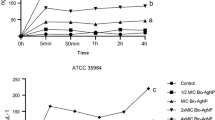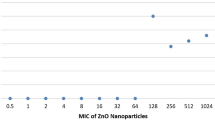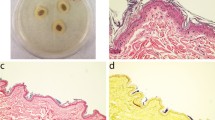Abstract
Staphylococcus aureus, particularly methicillin-resistant S. aureus (MRSA), is an important cause of pyogenic skin and soft tissue infections (SSTIs). MRSA is an important pathogen in the healthcare sector that has neither been eliminated from the hospital nor community environment. In humans, S. aureus causes superficial lesions in the skin and localized abscesses, pyogenic meningitis/encephalitis, osteomyelitis, septic arthritis, invasive endocarditis, pneumonia, urinary tract infections and septicemia. Investigations focused in the search of other alternatives for the treatment of MRSA infections are in progress. Among the range of compounds whose bactericidal activity is being investigated, ZnO nanoparticles (ZnO–NPs) appears most promising new unconventional antibacterial agent that could be helpful to confront this and other drug-resistant bacteria. The aim of present study is to investigate the antibacterial potential of ZnO–NPs against Staphylococcus species isolated from the pus and wounds swab from the patients with skin and soft tissue infections in a tertiary care hospital of north India. ZnO–NPs (≈19.82 nm) synthesized by sol–gel process were characterized using scanning electron microscopy, X-ray diffraction , and Atomic force microscopy. The antibacterial potential was assessed using time-dependent growth inhibition assay, well diffusion test, MIC and MBC test and colony forming units methods. ZnO–NPs inhibited bacterial growth of methicillin-sensitive S. aureus (MSSA), MRSA and methicillin-resistant S. epidermidis (MRSE) strains and were effective bactericidal agents that were not affected by drug-resistant mechanisms of MRSA and MRSE.






Similar content being viewed by others
References
Abudu L, Blair I, Fraise A, Cheng KK (2001) Methicillin-resistant S. aureus (MRSA). A community-based prevalence survey. Epidemiol Infect 126(3):351–356
Anapurba S, Sen MR (2003) Prevalence of methicillin resistant S. aureus in a tertiary referral hospital in eastern Uttar Pradesh. Ind J Med Micro 21:49–51
BSAC (British Society for Antimicrobial Chemotherapy) (2011) Methods for antimicrobial susceptibility testing. Version 10.2 May 2011
Centers for Disease Control and Prevention (2003).National Nosocomial Infections Surveillance (NNIS) system report: data summary from January 1992 through June 2003, issued August 2003. Am J Infect Control 31: 481–498
Chu SY, Yan TM, Chen SL (2000) Characteristics of sol-gel synthesis of ZnO-based powder. J Matter Sc Lett 19:349
Collee JG, Fraser AG, Marmion BP, Simmons A (1996) Mackie & McCartney, Practical Medical Microbiology, 14th edn. Churchill Livingston, New York
Emami-Karvani Z, Chehrazi P (2011) Antibacterial activity of ZnO nanoparticle on gram-positive and gram-negative bacteria. Afr J Microbiol Res 5(12):1368–1373
Jones N, Ray B, Ranjit KT, Manna AC (2008) Antibacterial activity of ZnO nanoparticle suspensions on a broad spectrum of microorganisms. FEMS Microbiol Lett 279:71–76
Kalyani G, Anil VG, Bo-Jung C, Yong-Chien L (2006) Preparation and characterization of ZnO nanoparticles coated paper and its antibacterial activity study. J. Green Chem 8:1034–1041
Laura KA, Delina YL, Pedro JJA (2006) Comparative eco-toxicity of nanoscale TiO2, SiO2, and ZnO water suspensions. J. Water Res 40:3527–3532
Lowy FD (1998) Staphylococcus aureus infections. N Engl J Med 339(8):520–532
Luo PG, Tzeng TR, Shah RR, Stutzenberger FJ (2007) Nanomaterials for antimicrobial applications and pathogen detection. Curr Trends Microbiol 3:111–128
Marcus CN, Paul AW (2007) ZnO tetrapod nanocrystals. J Mater Today 10(5):50–54
Matei A, Cernica I, Cadar O, Roman C, Schiopu V (2008) Synthesis and characterization of ZnO-polymer nanocomposites. Int J Mater Form 1:767–770
Mehata AP, Roderigue C (1998) Control of methicillin resistant S. aureus in a tertiary care center: a five-year study. Ind J Med Microbiol 16:31–34
Mehndiratta PL, Vidhani S, Mathur MD (2001) A study on S. aureus strains submitted to a reference laboratory. Indian J Med Res 114:90–94
NCCLS (National Committee for Clinical Laboratory Standards) (2003) Methods for dilution antimicrobial susceptibility tests for bacteria that grow aerobically: approved standard M7-A6. NCCLS, Wayne
NCCLS (National Committee for Clinical Laboratory Standards) (2006) Performance standards for antimicrobial susceptibility testing, fifteenth informational supplement, NCCLS document M100- S16. Vol 26–3; M7–A7, vol 26–2; M2–A9, vol 26–1. Wayne
Oliveira DC, Tomasz A, de Lencastre H (2002) Secrets of success of a human pathogen: molecular evolution of pandemic clones of methicillin-resistant S. aureus. Lancet Infect Dis 2(3):180–189
Padmavathy N, Vijayaraghavan R (2008) Enhanced bioactivity of ZnO nanoparticles—an antibacterial study. Sci Technol Adv Mater 9:035004 7 pp
Palavecino E (2004) Community-acquired methicillin-resistant S. aureus infections. Clin Lab Med 24(2):403–418
Raghupati RK, Koodali RT, Manna AC (2011) Size-dependent bacterial growth inhibition and mechanism of antibacterial activity of zinc oxide nanoparticles. Langmuir 27:4020–4028
Rahbar M, Yaghoobi M, Fattahi A (2006) Comparison of different laboratory methods for detection of Methicillin resistant S. aureus. Pak J Med Sci 22:442–445
Reddy KM, Kevin F, Jason B, Denise GW, Cory H, Alex P (2007) Selective toxicity of zinc oxide nanoparticles to prokaryotic and eukaryotic systems. J Appl Phys Lett 90(21):1–3
Rice LB (2006). Antimicrobial resistance in gram-positive bacteria. Am J Med 119(6 Suppl 1): S11–S19 (discussion S62–S70)
Sawai J (2003) Quantitative evaluation of antibacterial activities of metallic oxide powders (ZnO, MgO and CaO) by conductimetric assay. J Microbiol Methods 54:177–182
Shankar CU, Harish BN, Kumar PMU, Navaneeth BV, Udaya Shankar C, Umesh PM (1997) Prevalence of methicillin resistant S. aureus in JIPMER Hospital-a preliminary report. Indian J Med Microbiol 15:137–141
Shlaes DM, Gerding DN, John JF Jr, Craig WA, Bornstein DL, Duncan RA, Eckman MR, Farrer WE, Greene WH, Lorian V, Levy S, McGowan JE Jr, Paul SM, Ruskin J, Tenover FC, Watanakunakorn C (1997) Society for healthcare epidemiology of America and infectious diseases, society of America joint committee on the prevention of the antimicrobial resistance: guidelines for the prevention of antimicrobial resistance hospitals. Clin Infect Dis 25:584–599
Sobha K, Surendranath K, Meena V, Jwala KT, Swetha N, Latha KSM (2010) Emerging trends in nanobiotechnology. J Biotech Mol Bio Rev 5(1):001–012
Song MD, Wachi M, Doi M, Ishino F, Matsuhashi M (1987) Evolution of an inducible penicillin-target protein in methicillin-resistant S. aureus by gene fusion. FEBS Lett 221:167–171
Wahab R, Kim YS, Mishra A, SI Y, Shin HS (2010) Formation of ZnO micro-flowers prepared via solution process and their antibacterial activity. J Nanoscale Res Lett 5(10):1675–1681
Yamamoto O (2001) Influence of particle size on the antibacterial activity of zinc oxide. Int J Inorg Mater 3:643–646
Acknowledgments
The authors would like to acknowledge SAIF-DST, Department of Anatomy, All India Institute of Medical Sciences (AIIMS), New Delhi, India, for SEM observation of ZnO nanoparticle.
Conflict of interest
There is no conflict of interest between the authors.
Author information
Authors and Affiliations
Corresponding author
Rights and permissions
About this article
Cite this article
Ansari, M.A., Khan, H.M., Khan, A.A. et al. Characterization of clinical strains of MSSA, MRSA and MRSE isolated from skin and soft tissue infections and the antibacterial activity of ZnO nanoparticles. World J Microbiol Biotechnol 28, 1605–1613 (2012). https://doi.org/10.1007/s11274-011-0966-1
Received:
Accepted:
Published:
Issue Date:
DOI: https://doi.org/10.1007/s11274-011-0966-1




